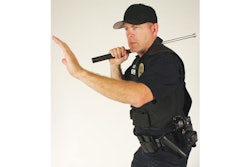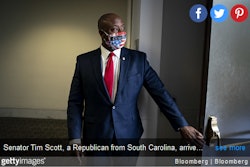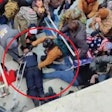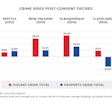 (Photo: Getty Images)
(Photo: Getty Images)
Does societal pressure have you considering placing a diagram of the use-of-force continuum back into your use-of-force policy? You don’t want to do that. And let me explain why.
First, let’s discuss the history and reasoning behind the decision to remove the continuum from use-of-force policies a decade ago. Then we’ll discuss why it is now unacceptable to revive it?
Law enforcement leaders and legal experts have worked tirelessly for nearly two decades to remove the stair-stepping methodology of the use-of-force continuum from police policies because of its continued failure to interpret current case law accurately. And having spent significant efforts in educating police executives and trainers for the last 15 years, I refuse to stand by and allow agencies to respond in a reactionary manner.
Years of research, training, and instruction has led to significant concerns that the use-of-force continuum may cause the unintended result of an increase in use of force by officers attempting to follow the stair-stepping application of a continuum rather than rely on a decision-making process. Use-of-force continuum diagrams present an overly simplistic approach to decision-making that detracts from the officer’s ability to make effective decisions when confronted by resistance in real time. Departments should encourage officers through contemporary policies and training to evaluate the situation with decision-making methods such as proper tactics, communication skills, and de-escalation tactics, rather than a stair-stepping methodology. We have been down this road before, and it is a dead end.
A Training Tool
The history of the use-of-force continuum can be traced back to the mid 1970s when Professor Gregory Connor created the first “force continuum” as an instructional aide, designed to assist criminal justice trainers throughout the country. LAPD developed the “Force Continuum Barometer,” which was published in their 1978 training bulletin. In 1980 longtime international trainer, Kevin Parsons, Ph.D., developed the “Confrontational Continuum.” According to Parsons, “The concept of the continuum was to explain to officers ‘when’ to use force options as opposed to the traditional defensive tactics class, which dealt only with ‘how’ to use force options. Thus, the continuum was designed to be a training tool.”
Historically, agencies and training providers developed their own use-of-force programs, generating a variety of contemporary continuums consisting of stair steps, ladders, barometers, matrices, etc., which total more than 50 different models. Through the years, continuums increased in complexity it seems for no other reason than to reinvent the wheel, producing several differing standards to explain to a jury.
So, what has history taught us over the years? My interpretation is that the stair-stepping is not a proper way to provide an explanation to an officer or a jury about force decision-making. Applying a static standard, an inaccurate diagram, to a rapidly evolving situation confuses officers during their decision-making process.
The Reasonable Standard
The continuum was removed from policies and operations because it did not properly represent the constitutional standards of a use of force based on “objectively reasonable” decision-making. Departments across the country took a bold step and abandoned the use-of-force continuum methodology and developed a more effective amendment-based use-of-force training program for their officers.
The training models used in the academy now teach use-of-force decision-making as the United States Supreme Court set forth in Canton v. Harris. The need to train officers in the constitutional limitations on the use of deadly force (see Tennessee v. Garner 471 U.S. 1 (1985)), can be said to be “so obvious,” that failure to do so could properly be characterized as “deliberate indifference” to constitutional rights.
In 1985, the Supreme Court ruled in Tennessee v. Garner that, “the use of deadly force to apprehend a suspect is a seizure under the Fourth Amendment objective reasonableness standard…” A police officer may not seize an unarmed, non-dangerous (fleeing felon) suspect by shooting him dead. In 1989, in Graham v. Connor, the Court embraced the Fourth Amendment objective reasonableness standard. The Court expanded post-incident analysis to include all uses of force. “The notion that all excessive force claims brought under § 1983 are governed by a single generic standard is rejected. Instead, courts must identify the specific constitutional right allegedly infringed by the challenged application of force and then judge the claim by reference to the specific constitutional standard which governs that right.”
The legal standard identified in Graham v. Conner is the law that guides an officer’s use-of-force decision-making process.
The Court has determined that the Fourth Amendment establishes the legal standard for use-of-force claims during an arrest, detention, or other seizure. The Fourth Amendment is the right of the people to be secure against unreasonable searches and seizures. The reasonableness of a particular use of force must be judged from the perspective of a reasonable officer on the scene, rather than with the 20/20 vision of hindsight. Not every push or shove, even if it may later seem unnecessary in the peace of a judge’s chambers violates the Fourth Amendment.
The calculus of reasonableness must allow for the fact that police officers are often forced to make split-second judgments about the amount of force that is necessary in a particular situation in circumstances that are tense, uncertain, and rapidly evolving. The reasonableness test in an excessive force case during an arrest, detention, or other seizure is an objective one. The question is whether the officer’s actions were “objectively reasonable” in the light of the existing facts and circumstances, without regard to their intent or motivation.
By 1989, it was clear that Tennessee v. Garner and Graham v. Conner had changed the post use of force analysis process for the courts, and indirectly provided an opportunity for use-of-force trainers to better instruct officers on clearly established law and the development of a legally sound decision-making process. Basically, it allowed officers to focus on the circumstances surrounding “why” there was a need to use force in addition to what level of force to use against a criminal suspect who poses a threat and is actively resisting.
Law enforcement executives across the country recognize that a change in use-of-force response may be necessary, but to abandon almost two decades of work and case study is not the proper answer. This became clear in early 2000 when there was a significant push to remove the use-of-force continuum from law enforcement policy.
Many notable law enforcement organizations, including San Jose, CA (2000), the Wyoming Law Enforcement Academy (2001), the FBI (2002), FLETC (2005), and LAPD (2009) started the process of moving away from the use-of-force continuum to the decision model of force decisions. The big concern with agencies was whether the U.S. Department of Justice would remove the continuum requirement from consent decrees issued throughout the country. That occurred in 2012 and has continued through the years, further proving that the continuum model is obsolete.
Reform and the Continuum
Over the years, presidents have assembled commissions to address “needed change” for law enforcement practices in response to social unrest. Improving police policies and training is typically in the mix of suggestions.
History repeats itself. Once again police reform is all the buzz, and much of the focus is on reform in police training concerning use of force. President Obama initiated the most recent task force, “Task Force on 21st Century Policing,” to “strengthen community policing and trust among law enforcement officers and the communities they serve.”
Leading police organizations held conferences, symposiums, and meetings to address the current issues. But why are we changing what has proven to be successful? How does what bringing back the continuum help when we all know that it was broken?
We do not need a new continuum to cause confusion; we need to train our officers on clearly established law pertaining to the use of force. Officers need to understand through continuous situational force decision-making training that poor police tactics can place them in a situation where deadly force is necessary and will lead to liability issues. Departments must focus on training officers to avoid poor tactics and hold officers accountable when they violate policy and training. When society sees that we are holding our officers accountable and putting in the work to train them, the push for old methodologies will die down, because it must. We can’t fix the wheel with gears that have already proved faulty. Let’s keep our current wheel moving forward in a way that history has taught us actually works. We must focus on policies and training that support effective decision making for our officers.
Eric Daigle is founder of Daigle Law Group, LLC, a firm that specializes in law enforcement operations. A former officer, Daigle focuses on civil rights actions, including police misconduct litigation. He is an advisor for police agencies. www.daiglelawgroup.com














